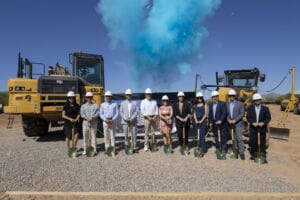The construction industry is as busy as we’ve ever seen it — and a historic number of projects are being built in cities across the country. At the same time, the industry is facing new challenges that will impede owners looking to build and test builders who aren’t prepared for change and the future of construction.
Builders must demonstrate their ability to take on today’s complex projects while protecting their clients from growing economic uncertainty and industry disruptors.
Current market conditions are producing many tremendous projects that need building. At the same time, builders across the industry are facing major disruptors. A historic shortage of labor, the ongoing technological transformation on jobsites and in offices, and expanding sustainability practices and requirements are pushing builders to adapt and evolve like never before.
ECONOMIC UNCERTAINTY

It’s an amazing time to be part of the construction industry. We’re going through an exceptional boom propelled by the country’s record-breaking economic expansion. But we all know every expansion is eventually followed by a contraction. What are the best ways to spot if your builder is prepared to weather the financial storm and ready for the future of construction?
What does their portfolio look like? It’s essential that clients understand the financial health of their builder of choice. Owning a diverse portfolio of work is one of the best ways to prepare for economic uncertainty. Having long-term projects across multiple market sectors insulates a builder from a downturn in a variety of market climates, ensuring they still have access to the finances and personnel needed to deliver value for clients.
Does the builder invest heavily in its workforce? Investing in talented people is the best way to grow capabilities and create new value for clients in any economic landscape. The philosophy of hiring the best people and continuously investing in their training and development ensures the builder has the people and talent necessary to deliver projects as expected — and will be ready to go in any type of economic conditions.
What kind of partner are they? As uncertainty grows, you need a partner that’s flexible and capable of delivering your project in multiple ways. Look for a partner that gets involved early, helps clients understand the extent of their capabilities and identifies what delivery methods will work best for them. The only way to create certainty from uncertainty is to build strong, transparent partnerships early in the process.
LABOR SHORTAGE
The great recession and subsequent boom have created a historic construction labor shortage. According to the U.S. Bureau of Labor Statistics, the industry has added more than 1.7 million jobs since 2009 and the construction unemployment rate has declined more than 20 points since its high in 2010. The shortfall is especially acute when it comes to craft labor, in large part because there are fewer people entering those professions than ever before.
What’s the best way to encourage more people to pursue craft professions? One of the primary reasons people aren’t considering construction careers is because they simply don’t know about the many opportunities that exist. Rarely do we see shop class in high schools anymore, even though learning a trade can enable workers to earn a high wage at a relatively young age. A strong community-based focus on grassroots efforts to help educate students, parents and teachers about possible construction careers is the best way to create a strong pipeline of future talent. The result? A more reliable and well-trained labor force across the market as the amount of construction projects continue to increase.
Builders must make recruiting, developing and retaining talent an anchor of how they do business to address this challenge. In addition to decreasing economic uncertainty, showcasing the value of learning a trade is a great way to recruit, retain and grow the craft labor population.
Access to talented, engaged and reliable craft labor also allows a builder to self-perform work. In addition to helping control costs and quality, self-perform capabilities are another way to decrease the impact of economic uncertainty. When you know a builder can rely on its own people to complete work, your project is no longer at the mercy of the labor market.
TECHNOLOGY & INNOVATION
Traditionally, the construction industry has done a poor job of improving productivity, but that’s slowly changing. Across the industry, builders are recognizing the value of innovative thinking and the many ways new technology can be applied to all phases of a project to improve results. Identifying a forward-thinking builder is easy if you know what to look for.
Innovation isn’t about new technology – it’s about thinking differently. It’s about creating a culture focused on continuously improving to deliver greater value. Every project is being built for the first time, and this approach attempts to challenge the status quo, to think of new ways to create value and explore them to improve the client experience.
Builders of tomorrow take advantage of what’s available today. Today, construction sites produce a wealth of unused or underutilized data. A team dedicated to analyzing the numbers can point to new, more efficient practices that improve safety, reduce waste and enhance quality. Before looking outward for solutions, builders should look inward and ensure they’re using the information already available to them to its fullest potential.
Keep an open mind about the future. Automation has changed other industries and the future of construction will be no different. Ten years ago, drone deliveries seemed farfetched — today, a robot putting up a wall feels the same way. Our industry isn’t there yet, but that doesn’t mean we shouldn’t be thinking about how our model can adapt to large scale change.
SUSTAINABILITY
Today, more than ever before, owners, builders and designers are aware of every project’s effect on the environment throughout the entire building process. A significant level of any building’s lifetime carbon footprint are the materials used in building. As environmental standards increase, owners will desire builders capable of delivering unique sustainability solutions.
Builders have a responsibility to promote environmentally friendly building practices. It has become standard operating procedure across the industry to drive toward more sustainable practices — but thinking ahead enables builders to actually weave sustainability into the fabric of their operations. By encouraging clients to consider sustainable building practices more and more solutions are designed and implemented. This is one place where true collaborative thinking can make a real difference.
Use of off-site production and prefabrication is going to increase. Project delivery is evolving. Off-site production can reduce waste, making it easier to consistently implement sustainable practices and materials into the building process. In addition to the environmental benefits, off-site production helps maximize productivity by safely and quickly allowing progress to be made both on and off the project site. There can be significant savings of time, energy and costs with proper use of prefabrication.
FUTURE OF CONSTRUCTION
Working with a builder who is only focused on today introduces enormous risk to your project when what you are really looking for is certainty. As an industry leader with 156 years of experience, we’ve seen what happens to builders, and their clients, when they aren’t prepared for changes in the market and for the future of construction. In a time when the industry is as good as we’ve ever seen it, you need a partner ready to help capitalize on opportunities today and protect your investment in the years to come.
In the search for certainty on your next project, look for partners who are successfully building today’s most complex projects, investing in the workforce of the future, embracing change and preparing for shifts in the economic landscape.
Ray Sedey currently serves as chief executive officer of McCarthy Holdings, Inc. He joined McCarthy in 2000 as a project engineer and moved through a variety of core operations and leadership positions prior to assuming his current role in 2020. Passionate about the workforce of the future, Ray is an active instructor and mentor in McCarthy’s leadership development program and advocate for diversity in the construction industry. He also plays an active role in the community through his involvement with a variety of organizations including the American Heart Association. Ray holds a Bachelor of Science in construction engineering from Montana State University.





